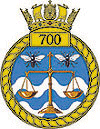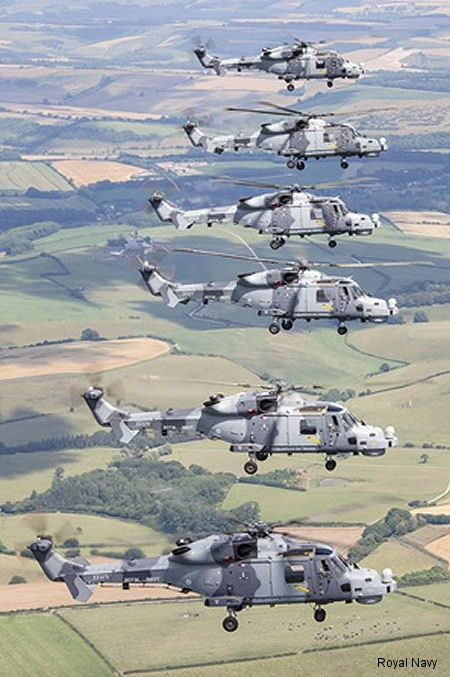
Originally formed in Jan 1940 at Hatston (HMS Sparrowhawk) in a plan to centralise the operations of the 700 series Catapult flights, around the Scapa Flow base. Disbanded Mar 1944, into 771 Squadron, B Flight. 
It is convenient for presentation to show the Intensive Flying Trials Units (IFTU) together under the 700 Naval Air Squadron numberplate but they effectively operated as independent formations with their own specialist objectives. The following information only shows the rotary wing work done. Important fixed wing tasks were also undertaken by 700A, B, G, P, Y and 700Z for the Fleet Air Arm. 
Its post WWII tasks gave a hint of its famous rotary wing roles to come. It reformed first as a Test Pilot School in Oct 1944, then after disbanding in 1949, it re-emerged in Aug 1955 as a Trials unit to disband again at RNAS Yeovilton in July 1961. 
From 18 Mar 1957, 700(H) operated from RNAS Lee-on-Solent to introduce the Whirlwind HAS.7 into FAA service and demonstrate the effectiveness of the fuel tank location, torpedo housing and in other improvements over the Whirlwind HAR.5, from which it was derived. As a result of its work, the type was introduced into 845 Squadron in Jun 1957 (replacing the Whirlwind HAS.22), followed during 1958 by 820, 824 and 815 Squadrons. It disbanded in Sep 1957. 
In Oct 1959, 700(X) formed at Yeovilton with the Sauders Roe P.531 to investigate what would be needed to introduce a whole new form of helicopeter operation to the Fleet - from small ships' flight decks. As well as deck handling, trials with a folding tail, choice of landing gear and flight deck equipment, the success of its work led to the first production order for the Wasp HAS.1 from Westland at Hayes. It disbanded in Jun 1961. 
700(H) was reformed in Jan 1960 at RNAS Culdrose to introduce the Wessex HAS.1 to RN service. Apart from fleet handling, its main job was to devise effective operating techniques for the familiar Type 194 Sonar (the same as fitted in the Whirlwind HAS.7), using a more powerful turbine engine and automatic flight stabilisation assistance, especially at night. It also finessed the Whirlwind technique of transiting from old to new hover locations with aplomb. The unit's spectacular results led directly to the formation of 815 Squadron in Jul 1961, followed by 819 and 814 Squadrons, both in autumn 1961. 
In Jun 1963, following the pioneering work of 700(X) IFTU, 700(W) IFTU was formed at RNAS Culdrose to determine the most effective fleet operating procedures and mission profiles for the Wasp HAS.1. For the first time, any suitably equipped surface vessel could direct a Wasp remotely, to allow it to unload its torpedo payload onto a submarine contact the Wasp had found with its own airborne sonar - a real force multiplier. It disbanded in March 1964, to form the basis of 829 Squadron. 
To cope with the radically improved performance of the twin turbine Wessex HU.5, its potential armaments and externally slung lift capability in the Commando Assault role, 700(V) IFTU formed at RNAS Culdrose on 5 Dec 1963 to introduce the powerful and rugged new type into RN service. Its work enabled the first front line Wessex HU.5 unit, 848 Squadron to form in Oct 1964, followed by the Commando Advanced Flying Training Unit in Dec 1964 and 845 Squadron in Oct 1965. It disbanded in Oct 1964. 
The Wessex HAS.3 first flew in 1966 and in Jan 1967, 700(H) IFTU was reformed at RNAS Culdrose to introduce the much improved version into RN service. New operating procedures were required for the Type 195 Sonar set, and the Ecko radar situated in the Camels Hump aft of the main rotor head. It also faced the challenge of devising viable mission profiles with the weight of new equipment, plus the weapon system, within the airframes performance envelope. Its success contributed to the formation of the first Wessex HAS.3 unit, 814 Squadron in Oct 1967. The Advanced Flying Training Squadron was next, followed by the Observer Advanced & Operational Flying Training Squadron, 820, 819 and 826 Squadrons in Oct 1968. 700(H) disbanded with its 5 airframes in Sep 1967. 
Just 3 months after the first flight of the Sea King HAS.1, 700(S) Squadron formed at RNAS Culdrose in Aug 1969 to evaluate the type's performance and effectiveness in the anti-submarine role. Initially equipped with the same well understood sensors proven by 700(H) when it introduced the Wessex HAS.3, 700(S) successfuly demonstrated the superior performance and endurance of the Sea King. Its work paved the way for the creation of 706 Squadron in Jan 1970, followed by the first front line Sea King HAS.1 unit, 824 Squadron in Feb 1970, then 826 in Jun 1970, 737 in Jul 1970, 819 in Feb 1972, 820 in Dec 1972 and 814 Squadron in Mar 1973. 700(S) disbanded in May 1970. 
In Sep 1976, 700(L) IFTU formed at RNAS Yeovilton tasked with introducing the Lynx HAS.2 into RN service. A considerable body of Small Ships knowledge had been accumulated through the work of 700(X) and 700(W) IFTUs with the Wasp HAS.1 and much work had been done by Westland in the 4 years since the first Naval Lynx prototype flew. It was unique in that it was a joint Royal Navy and Royal Dutch Navy unit (the Dutch had ordered the SH-14B version). Live deck landing trials began on HMS Birmingham (D86) in Feb 1977. The Dutch contingent departed in May 1977, while 700(L) IFTU disbanded in Dec 1977 to reform as 702 Squadron in Jan 1978. 
In a break from tradition, the Sea King HAS.6 IFTU work was not undertaken by a 700 Squadron formation. It began with 824 Squadron in Apr 1988 and subsequently transferred to 819 Squadron in Mar 1989. 
700(L) reformed at RNAS Portland (HMS Osprey) from 702 Squadron Lynx Operational Flying Trials Unit in Jul 1990, to introduce the Racal Avionics Central Tactical System (CTS) into the Lynx HAS.3 fleet. Once its job was done, 700(L) was absorbed into 815 Squadron in Jul 1992. 
Re-commissioned at RNAS Culdrose in December 1998 to form the Intensive Flying Trials Unit (IFTU) for the introduction into Naval Service of AgustaWestland Merlin. Since September 2001 the role of the Squadron changed when the IFTU was disbanded and a new unit, the Operational Evaluation Unit (OEU) was formed equipped with the Merlin HM Mk 1 being responsible for delivering Operational Capability to the Fleet. 
Reformed in May 2009 as 700(W) at RNAS Yeovilton as the Wildcat Fielding Squadron to introduce the Lynx Wildcat HMA.2 into Royal Navy service. Trials on RFA Argus, HMS Iron Duke and RFA Mounts Bay. Decommissioned on 30 Jul 2014 at RNAS Yeovilton, after introducing the Wildcat HMA.2 to the Fleet Air Arm. Personnel and airframes went on to form 825 Squadron on 1 Aug. 
The latest incarnation is 700 X Flt which reformed at RNAS Culdrose on 1 Oct 2014 to develop the Scan Eagle UAV, which has so far been operated successfully from Type 23 frigates
HMS Somerset,
HMS Northumberland,
HMS Kent and
HMS Richmond. 
News about 700 Squadron |

Royal Navy 700W Squadron become 825 NAS
31-Jul-14 - Yesterday saw the decommissioning of 700 (W) Naval Air Squadron (NAS) following 5 years of hard work, diligence and dedication at Royal Naval Air Station (RNAS) Yeovilton.
|
700 Squadron Operations |
| Dates | Operation | |
|---|---|---|
| 2014-mar-31 | 2014-apr-11 | Exercise Joint Warrior 14-1 |
| 1977-jun-25 | 1977-jun-28 | Fleet Review: Silver Jubilee of HM The Queen |
| 1970-may-14 | 1970-may-15 | Rescue from tanker Tiskeri |
